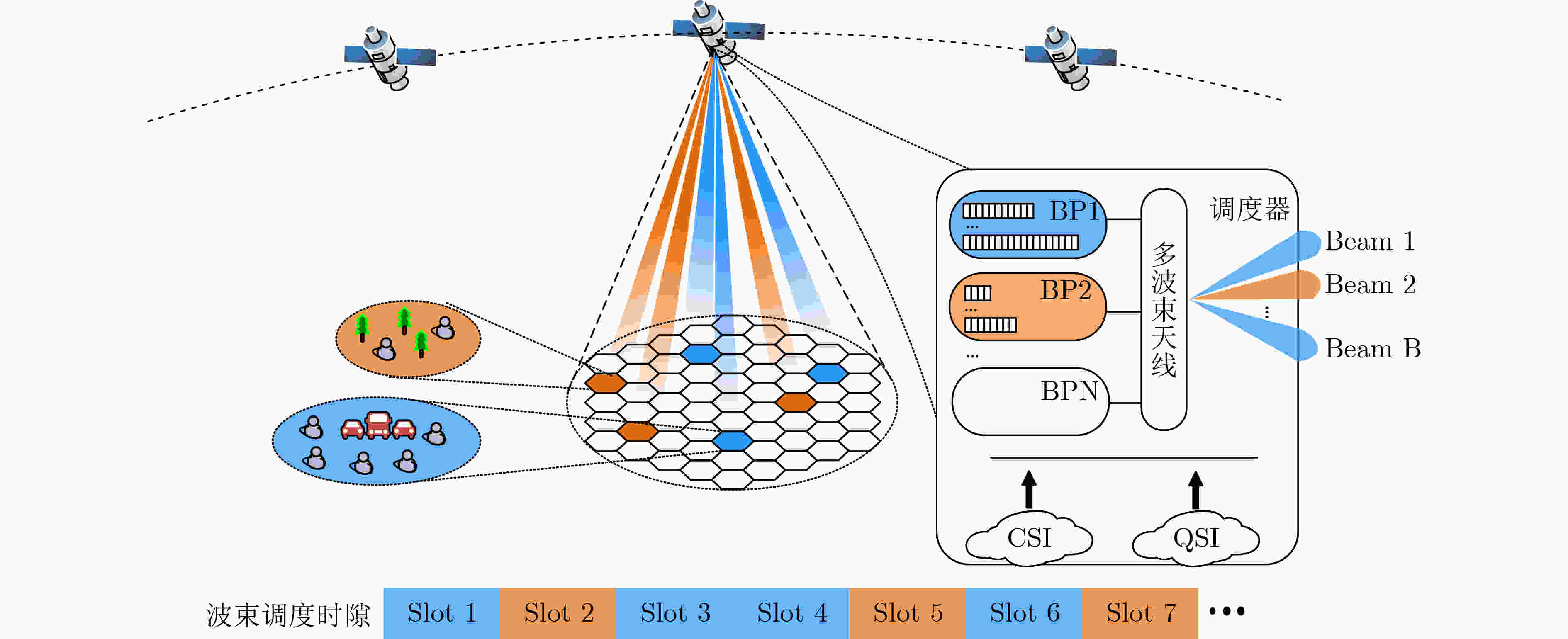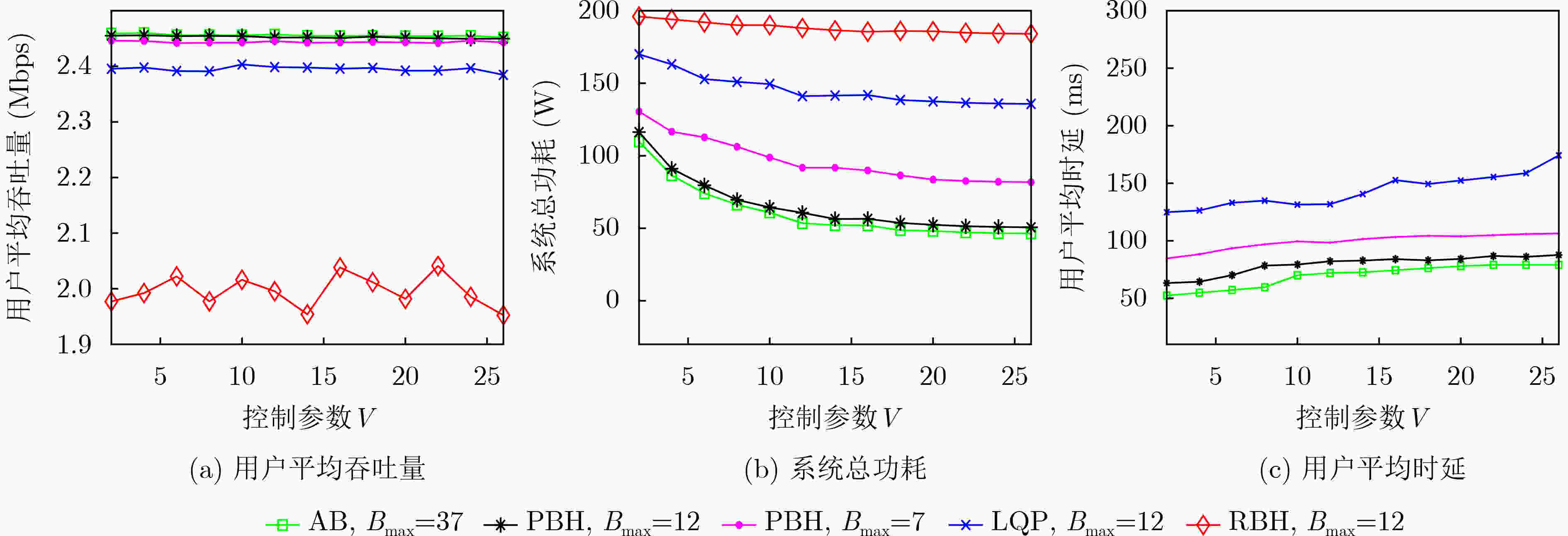Joint Beam Hopping Scheduling and Power Allocation of LEO Satellites Oriented Energy Efficiency
-
摘要: 该文针对低轨(LEO)卫星载荷容量受限且功率资源稀缺的问题,面向搭载跳波束(BH)天线的低轨卫星通信系统,提出一种联合跳波束调度和功率分配机制,在满足用户服务质量需求的前提下降低卫星通信载荷功耗,提高卫星通信系统能效。首先建立时延受限下联合考虑波束调度和功率分配的卫星功耗最小化模型。针对网络拓扑的时变特性,基于李雅普诺夫优化方法,将原多时隙优化问题转化为单时隙优化问题,然后采用交替优化的方法获得单时隙问题的次优解。其中,证明波束调度子问题是凸问题,同时通过逐次凸近似和对数变换将功率分配子问题转为凸问题,并提出相应算法获得子问题最优解。仿真结果表明,提出的策略在保证用户平均时延要求的同时,降低了低轨卫星系统平均功耗,并且可通过调整控制参数实现时延和功耗的动态平衡。Abstract: In Low Earth Orbit (LEO) satellite networks, the capacity of satellite payload is limited strictly, and onboard power resource is extremely scarce. Thus, a joint Beam Hopping (BH) scheduling and power allocation scheme is proposed to reduce onboard power resources consumption for the LEO system with BH antennas, while meeting quality of service requirements of users, so that the energy efficiency of the satellite communication system can be improved. Firstly, the joint beam scheduling and power allocation problem with delay constraints is formulated to minimize the power consumption of the satellite system. Considering the time-varying topological characteristics of the system, the original multi-slot optimization problem is transformed into a single-slot optimization problem based on the Lyapunov optimization method, and then the alternate optimization method is employed to obtain the sub-optimal solution of the single-slot problem. Specifically, the beam scheduling subproblem is proved to be convex, the power distribution subproblem is transformed into convex by successive convex approximation and logarithmic transformation, and the corresponding algorithm is proposed to obtain the optimal solution of the subproblems. Simulation results show that the proposed scheme can reduce the onboard power consumption of the satellite while ensuring the average time delay requirement of the users, and the dynamic balance of the delay and the power consumption can be achieved by adjusting the control parameter.
-
Key words:
- LEO satellites /
- Energy efficiency /
- Beam hopping /
- Power allocation /
- Lyapunov optimization method
-
算法1 联合波束调度和功率分配算法 (1) 输入:各用户初始队列长度$ {Q_u}(0) $,最大时间平均时延$ {D_{u,\max }} $,控制参数$ V $,问题式(19)与式(21)分别的原对偶内点法阈值$ {\xi _1} $和$ {\xi _2} $,SCA算法的阈值$ {\zeta _{{\text{sca}}}} $,交替优化算法阈值$ {\zeta _{{\text{alt}}}} $ (2) For $t = 1,2, \cdots, T$ do (3) 按照上文给出的方法给功率分配和波束调度的初始可行解$ {{{p}}^{\left( 0 \right)}} $和$ {{{x}}^{\left( 0 \right)}} $,并计算式(17)的目标函数值${f_{{\rm{P}}3} }\left( { { {{p} }^{\left( 0 \right)} },{ {{x} }^{\left( 0 \right)} } } \right)$ (4) While $\left| { {f_{{\rm{P}}3} }\left( { { {{p} }^{\left( k \right)} },{ {{x} }^{\left( k \right)} } } \right) - {f_{{\rm{P}}3} }\left( { { {{p} }^{\left( {k - 1} \right)} },{ {{x} }^{\left( {k - 1} \right)} } } \right)} \right| > {\zeta _{ {\text{alt} } } }$ do (5) 给定$ {{{p}}^{\left( k \right)}} $,并以$ {{{x}}^{\left( k \right)}} $为初始迭代点,通过内点算法解决式(19),当对偶间隙小于$ {\xi _1} $时内点法终止,其最优解为$ {{{x}}^{\left( {k + 1} \right)}} $ (6) 根据$ {{{x}}^{\left( {k + 1} \right)}} $和$ {{{p}}^{\left( k \right)}} $计算$ \omega _u^{(k,0)} $和P6目标函数的最优值$f_{{\rm{P}}6}^*\left( { { {{p} }^{\left( {k,0} \right)} },{ {{x} }^{\left( k \right)} } } \right)$,进而获得SCA近似参数$ c_{u,n}^{(k,0)} $和$ v_{u,n}^{(k,0)} $ (7) While $\left| { {f_{{\rm{P}}6} }\left( { { {{p} }^{\left( {k,l} \right)} },{ {{x} }^{\left( {k + 1} \right)} } } \right) - {f_{{\rm{P}}6} }\left( { { {{p} }^{\left( {k,l - 1} \right)} },{ {{x} }^{\left( {k + 1} \right)} } } \right)} \right| > {\zeta _{ {\text{sca} } } }$ do (8) 依据$ {{{p}}^{\left( {k,l} \right)}} $计算$ c_{u,n}^{(k,l + 1)} $和$ v_{u,n}^{(k,l + 1)} $ (9) 通过内点算法解决问题P6,当对偶间隙小于$ {\xi _2} $时停止,其最优解为$ {{{p}}^{\left( {k,l{\text{ + }}1} \right)}} $,同时令$ l = l + 1 $ (10) End while (11) $ {{{p}}^{\left( {k + 1} \right)}} \leftarrow {{{p}}^{\left( {k,l} \right)}} $,并且计算${f_{{\rm{P}}3} }\left( { { {{p} }^{\left( {k + 1} \right)} },{ {{x} }^{\left( {k + 1} \right)} } } \right)$,同时令$ k = k + 1 $ (12) End while (13) 根据式(6)和式(10)更新$ {Q_u}(t + 1) $和$ {Y_u}(t + 1) $ (14) End for (15) 输出:每个调度时隙的(近似)最优波束调度策略和功率策略 表 1 多波束低轨卫星场景参数设定
低轨卫星网络参数 取值 低轨卫星网络参数 取值 卫星轨道高度 1200 km 系统子信道数W 100 卫星波束个数B 7 下行链路工作频率f 26.5 GHz 服务小区总数N 37 卫星发射天线增益$ {G_0} $ 30.5 dBi 小区半径 90 km 噪声功率密度N0 –174 dBm/Hz 用户数U 200 卫星最大发射功率$ {p_{\max }} $ 200 W 用户分布 平面热点分布 单用户的最大发射功率$ {p_{u,\max }} $ 5 W 热点分布参数(a,c) (80,6) 多波束天线半波束角 $ {4.4^ \circ } $ 子信道带宽$ \Delta f $ 180 kHz 数据流到达速率均值$ {\lambda _u} $ [1,2.5] Mbps -
[1] 徐晖, 孙韶辉. 面向6G的天地一体化信息网络架构研究[J]. 天地一体化信息网络, 2021, 2(4): 2–9. doi: 10.11959/j.issn.2096-8930.2021037XU Hui and SUN Shaohui. Research on network architecture for the space-integrated-ground information network in 6G[J]. Space-Integrated-Ground Information Networks, 2021, 2(4): 2–9. doi: 10.11959/j.issn.2096-8930.2021037 [2] KODHELI O, LAGUNAS E, MATURO N, et al. Satellite communications in the new space era: A survey and future challenges[J]. IEEE Communications Surveys & Tutorials, 2021, 23(1): 70–109. doi: 10.1109/COMST.2020.3028247 [3] SU Yongtao, LIU Yaoqi, ZHOU Yiqing, et al. Broadband LEO satellite communications: Architectures and key technologies[J]. IEEE Wireless Communications, 2019, 26(2): 55–61. doi: 10.1109/MWC.2019.1800299 [4] WANG Yaxin, BIAN Dongming, HU Jing, et al. A flexible resource allocation algorithm in full bandwidth beam hopping satellite systems[C]. 2019 IEEE 3rd Advanced Information Management, Communicates, Electronic and Automation Control Conference (IMCEC), Chongqing, China, 2019: 920–927. [5] TANG Jingyu, BIAN Dongming, LI Guangxia, et al. Optimization method of dynamic beam position for LEO beam-hopping satellite communication systems[J]. IEEE Access, 2021, 9: 57578–57588. doi: 10.1109/ACCESS.2021.3072104 [6] ANZALCHI J, COUCHMAN A, GABELLINI P, et al. Beam hopping in multi-beam broadband satellite systems: System simulation and performance comparison with non-hopped system[C]. 2010 5th Advanced Satellite Multimedia Systems Conference and the 11th Signal Processing for Space Communications Workshop, Cagliari, Italy, 2010: 248–255. [7] ANGELETTI P, PRIM D F, and RINALDO R. Beam hopping in multi-beam broadband satellite systems: System performance and payload architecture analysis[C]. Proceedings of the 24th AIAA International Communications Satellite Systems Conference (ICSSC), San Diego, USA, 2006: 1–11. [8] WANG Anyue, LEI Lei, LAGUNAS E, et al. Joint beam-hopping scheduling and power allocation in NOMA-assisted satellite system[C]. 2021 IEEE Wireless Communications and Networking Conference (WCNC), Nanjing, China, 2021: 1–6. [9] WANG Libing, HU Xin, MA Shijun, et al. Dynamic beam hopping of multi-beam satellite based on genetic algorithm[C]. 2020 IEEE Intl Conf on Parallel & Distributed Processing with Applications, Big Data & Cloud Computing, Sustainable Computing & Communications, Social Computing & Networking (ISPA/BDCloud/SocialCom/SustainCom), Exeter, UK, 2020: 1364–1370. [10] HU Xin, ZHANG Yuchen, LIAO Xianglai, et al. Dynamic beam hopping method based on multi-objective deep reinforcement learning for next generation satellite broadband systems[J]. IEEE Transactions on Broadcasting, 2020, 66(3): 630–646. doi: 10.1109/TBC.2019.2960940 [11] MA Yuanyuan, LV Tiejun, ZHANG Xuewei, et al. High energy efficiency transmission in MIMO satellite communications[C]. 2018 IEEE International Conference on Communications (ICC), Kansas City, USA, 2018: 1–6. [12] SHARMA S K, CHATZINOTAS S, and OTTERSTEN B. Cognitive beamhopping for spectral coexistence of multibeam satellites[C]. 2013 Future Network & Mobile Summit, Lisboa, Portugal, 2013: 1–10. [13] ZHOU Zhenyu, GUO Yufei, HE Yanhua, et al. Access control and resource allocation for M2M communications in industrial automation[J]. IEEE Transactions on Industrial Informatics, 2019, 15(5): 3093–3103. doi: 10.1109/TII.2019.2903100 [14] BEA J, LEE J, and CHONG S. Learning to schedule network resources throughput and delay optimally using Q+-learning[J]. IEEE/ACM Transactions on Networking, 2021, 29(2): 750–763. doi: 10.1109/TNET.2021.3051663 [15] YANG Heng, WEI Zhiqing, FENG Zhiyong, et al. Queue-aware dynamic resource allocation for the joint communication-radar system[J]. IEEE Transactions on Vehicular Technology, 2021, 70(1): 754–767. doi: 10.1109/TVT.2020.3042551 [16] BOYD S, VANDENBERGHE L, 王书宁, 许鋆, 黄晓霖, 译. 凸优化[M]. 北京: 清华大学出版社, 2013: 73–85, 233–241, 550–555, 580–587.BOYD S, VANDENBERGHE L, WANG Shuning, XU Yun, HUANG Xiaolin translation. Convex Optimization[M]. Beijing: Tsinghua University Press, 2013: 73–85, 233–241, 550–555, 580–587. [17] TIAN Feng, HUANG Liling, LIANG Guang, et al. An efficient resource allocation mechanism for beam-hopping based LEO satellite communication system[C]. 2019 IEEE International Symposium on Broadband Multimedia Systems and Broadcasting (BMSB), Jeju, Korea (South), 2019: 1–5. -






 下载:
下载:





 下载:
下载:
